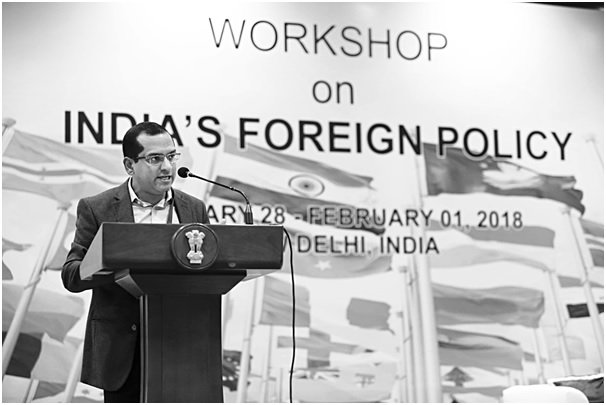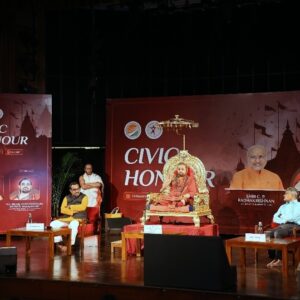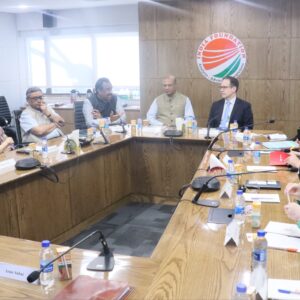India is a $ 2.5 trillion economy that is growing by 7-10% a year. It is the seventh largest economy in the world in nominal terms. It took us 60 years to become a $1 trillion economy but only seven years after, we added another $2 trillion. We are expected to become $3 trillion by 2019-2020 and $4 trillion by 2024. In terms of global wealth creation our figures are doing what continents do. The other dimension to our economy is that we are still a poor country. Our GDP per capita is $1600 and this reflects in our rankings. Interestingly, both these facts continue to exist in parallel and the irony is that both are true. Therefore, it will require a lot of time and effort to make a difference to the lives of Indians. We must also be aware while talking about the Indian economy that this is not a normal economy.
It is in this context that the government under Prime Minister Modi was elected. To understand the Prime Minister’s reforms we need to understand “shared economy” — creating prosperity and sharing it. The contours of Prime Minister Modi’s economic reforms point to a few trends. First, there is a breakout trend. It is for the first time that India has started to think big about what it wants to achieve. The Prime Minister’s Make in India, Jan DhanYojana and Smart Cities are all big and ambitious projects.
Second, this government is following a two pronged approach, a top-down along with a bottom-up approach. The bottom-up approach emphasises inclusiveness while the top-down approach emphasises policies that accelerate growth through shared prosperity. Other elements of the top-down approach include unlocking state-controlled resources such as coal, oil and gas and telecom spectrum allocation where we raised $330 billion, $40 billion and $26 billion respectively.
Third, we recognise that we cannot accelerate growth without attracting investment. The dividends of the Prime Minister’s push to attract foreign investment are visible today – we are the largest receivers of FDI having doubled from approximately $30 billion four years ago to $65 billion today. Fourth, India introduced GST to create a common tax net. This progressive tax system is destination based, multistage and on value addition. Keeping aside the teething problems, GST alone will add $250 to $500 billion in incremental GDP and 1.5% to 2% increase in GDP per year. More importantly, it will reduce production costs by 10%. In the Indian context, these are very large numbers.
Fifth, an increase in GDP will not necessarily result in shared prosperity unless we create employment. The manufacturing sector can alone absorb a million people every month into the workforce but accounts for only 16% of our GDP. Economists suggest we need to increase this to 25-30% of our GDP to add hundred million jobs over the course of the next five years. Unfortunately we have not been able to reach these goals but the government has pushed for a growth in the sector through Make in India and indigenous defence procurement. Yet, constraints like cost of capital, skilled manpower and innovation remain.
Sixth, the government has focused tremendously on the fight against corruption through demonetisation, renegotiation of tax treaties with tax havens, Black Money (Undisclosed Foreign Income and Assets) and Imposition of Tax Act 2015 and Income Declaration Schemes. Corruption is a long haul social fight but fighting corruption will contribute to the growth of our economy, as the economy pays a huge price in terms of innovation and crowds out talent due to corruption. It is estimated that 25% of India’s GDP is in the black economy. When “black money” comes back into the system it can be used for more productive purposes to boost the economy. Therefore, combating corruption will play a role in helping India’s transition from a $3 billion economy to $4 billion economy.
Seventh, one of the biggest challenges that prohibits us from becoming a globally competitive economy is that our cost of capital is very high, making it difficult for the Indian entrepreneur to become globally competitive. Therefore, reforming the banking sector is necessary to lower the cost. In the next three to four years we will be able to see the impact of the changes in the banking sector. The progress that our country has achieved in the last four years is unprecedented.
These initiatives will allow greater wealth to be created. More importantly, it will allow for shared prosperity as one cannot have islands of prosperity in a sea of poverty. Lack of shared prosperity leads to violence and Maoism. In 2011, could lead out of 250 million households, 145 million had access to banking. In rural areas out of 170 million households, 90 million had access while in urban areas out of 80 million households, 53 million had access. From 2014 to 2018, 308 million bank accounts had been opened of which 180 were in rural areas and 126 million in urban areas, which is more than what India achieved in the first 65 years of independence. Moreover, 90% of the newly opened bank accounts are being used and 232 million RuPay debit cards were issued. With opening of these accounts, benefits can be directly transferred saving the government about 57,000 crores. Unsurprisingly, the number of beneficiaries also increased from 10 crore to 65 crore people. Therefore, when India transitions into its 75th or 100th year, it will not be a small transition but will be a transition that will swing the entire GDP of the world. The question now remains that when this prosperity comes will India have the receiving systems or the architecture to allow the prosperity to be distributed? The Soviet Union is a classic example of a country that could not absorb the benefits of opening up. In conclusion, to fully understand the economic reforms over the last four years we must think of two terms — “shared prosperity” and “changing India’s economic architecture”.
( This article is a summary of the address delivered by Shri ShauryaDoval, Director,
India Foundation on 1st February, 2018 at New Delhi at the Workshop on India’s Foreign Policy
organised by India Foundation in partnership with the Ministry of External Affairs, Government of India.)
(This article is carried in the print edition of March April 2018 issue of India Foundation Journal.)




